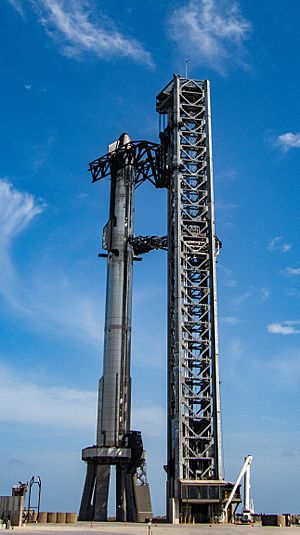SpaceX Starship facts for kids

A Starship prototype in launch configuration: Starship spacecraft S24 stacked on Super Heavy B7.
|
|
| Function | Super-heavy lift launch vehicle |
|---|---|
| Project cost | At least US$5 billion |
| Cost per launch | $100 million (expendable) |
| Size | |
| Height | 121.3 m (398 ft) |
| Diameter | 9 m (30 ft) |
| Mass | 5,000,000 kg (11,000,000 lb) |
| Capacity | |
| Payload to LEO | 100,000–150,000 kg (220,000–330,000 lb) |
| Associated rockets | |
| Derivatives | Starship HLS |
| Comparable |
|
| Launch history | |
| Status | In development |
| Launch sites |
|
| Total launches | 5 |
| Successes | 3 |
| Failures | 2 (IFT-1, IFT-2) |
| First flight | 20 April 2023 |
| Last flight | 13 October 2024 |
| First stage – Super Heavy | |
| Length | 71 m (233 ft) |
| Diameter | 9 m (30 ft) |
| Empty mass | 275,000 kg (606,000 lb) |
| Gross mass | 3,675,000 kg (8,102,000 lb) |
| Propellant mass | 3,400,000 kg (7,500,000 lb) |
| Engines | 33 × Raptor engines |
| Thrust | 74,400 kN (16,700,000 lbf) |
| Specific impulse | SL: 327 s (3.21 km/s) |
| Fuel | CH 4 / LOX |
| Second stage – Starship | |
| Length | 50.3 m (165 ft) |
| Diameter | 9 m (30 ft) |
| Empty mass | ~100,000 kg (220,000 lb) |
| Gross mass | 1,300,000 kg (2,900,000 lb) |
| Propellant mass | 1,200,000 kg (2,600,000 lb) |
| Engines | 3 × Raptor engines 3 × Raptor vacuum engines |
| Thrust | 12,300 kN (2,800,000 lbf) |
| Specific impulse | SL: 327 s (3.21 km/s) vac: 380 s (3.7 km/s) |
| Fuel | CH 4 / LOX |
Starship is a two-stage fully reusable super heavy-lift launch vehicle under development by SpaceX. On April 20, 2023, with the first Integrated Flight Test, Starship became the most massive and most powerful vehicle ever to fly. SpaceX has developed Starship with the intention of lowering launch costs using economies of scale. SpaceX aims to achieve this by reusing both rocket stages by "catching" them with the launch tower's systems, increasing payload mass to orbit, increasing launch frequency, mass-manufacturing the rockets and adapting it to a wide range of space missions. Starship is the latest project in SpaceX's reusable launch system development program and plan to colonize Mars.
Starship has two stages: the Super Heavy booster and the Starship spacecraft. Both stages are equipped with Raptor engines, the first mass-produced full-flow staged combustion cycle engines, which burn liquid methane (natural gas) and liquid oxygen. The main structure is made from a special stainless steel alloy that SpaceX has dubbed "30X".
As of 2024, Starship is in development with an iterative and incremental approach, involving test flights of prototype vehicles. As a successor to SpaceX's Falcon 9 and Falcon Heavy rockets, Starship is intended to perform a wide range of space missions. SpaceX plans versions of the Starship spacecraft including: cargo (satellite deployment), tankers to act as depots for in-orbit refueling of other Starships, human spaceflight, landing on the Moon, and eventually landing on Mars. For missions to further destinations, such as geosynchronous orbit, the Moon, and Mars, Starship will rely on orbital refueling from the tanker variant; a ship-to-ship propellant transfer demonstration is expected to occur in 2025 to prove out this critical capability. Starship is planned to deploy SpaceX's second-generation Starlink satellite constellation, and the Starship HLS variant will land astronauts on the Moon as part of the Artemis program, starting with Artemis III in 2026.
Images for kids
-
SpaceX CEO Elon Musk holding a model of BFR.
-
Booster 12 is successfully caught by the launch tower during flight test 5
-
Artemis III launch profile of a human landing on the Moon, involving Starship HLS, Starship tanker variants, and Orion spacecraft
-
Ship 27, Ship 26 and Booster 10 forward section under construction in Starbase build site, March 2023
See also
 In Spanish: Starship (SpaceX) para niños
In Spanish: Starship (SpaceX) para niños











